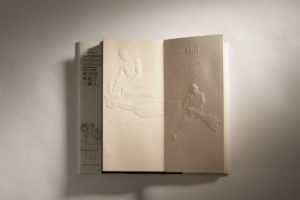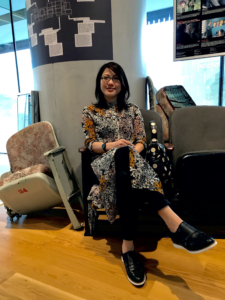Jesvin Yeo / LICC 2022 Winner
Interview with Jesvin Yeo, LICC Winner in ILLUSTRATE (Graphic) in the Professional category, reveals that her creative passion is deeply rooted in a profound love for her heritage and the cultural diversity that enriches her work. Yeo’s creative journey is guided by the harmonious relationship between exploration, insight, and purpose, which serves as the core focus of her design endeavors.
Tell us a little about your background. How did your love of design grow?
I am a graphic designer who thrives on conceptual and thought-provoking ideas. During my
previous stint as an art director for international advertising agencies, I enjoyed going beyond
typical ad output and combining creative concepts with innovative graphic design. My love of
design has flourished through my exploration of unconventional graphic design. I actively
immersed myself in design principles and theories, analysing the masterpieces crafted by icons
such as Helmut Schmidt, Paula Scher, Paul Rand, and Neville Brody. In addition, I avidly
research the rich history of graphic design and typography, uncovering its rich history and
evolution.
What merits do you see in being Winner in Illustrate (graphic)? What does receiving this
award personally mean to you?
Winning the Best in Illustrate (Graphic) award validates my efforts, affirming that my work has
been recognized as exceptional by fellow peers and industry experts. This prestigious accolade
serves as a testament to the positive impact my design creations have on the design industry.
My hope is that this achievement will inspires others and sets new standards for creativity and
innovation. Above all, this award has reinvigorated my commitment to my craft, motivating me to
continually push creative boundaries and relentlessly pursue excellence in all of my creations.
What steps do you take in the creative process, and what tools do you use?
My creative process is deeply rooted in research. To begin, I draw inspiration and pinpoint trends
from a wide array of sources including design books, online platforms, art exhibitions, and
everyday encounters. As I delve into concept development, I explore diverse strategies for
addressing the design challenge. I bounce ideas with my team and iterate to refine concepts
based on creativity, alignment with project objectives, and feasibility. Personally, I find that my
ideation flourishes when I engage with pen and paper.
Where do you find your inspiration and motivation for your work?
The driving force behind my creative endeavours stems from an unwavering affection for my
heritage and the richness of diverse cultures. My enthusiasm for heritage preservation is not
merely theoretical, it’s an active pursuit that engages me on multiple levels. I ardently seek
collaborations with traditional craftsmen and local communities, recognizing that their expertise
holds the keys to centuries-old techniques and wisdom. These partnerships are the heart of my
methodology, as they grant me invaluable insights into the intricacies of craftsmanship and the
essence of time-honored artistry. In my quest for innovative design solutions, I weave together
the threads of history and modernity. The challenge is to harmonize the narratives of the past
with the demands of the present, a task that requires ingenuity and sensitivity. My creations bear
the imprint of this delicate balance, where the echoes of tradition coexist seamlessly with the
pulse of contemporary aesthetics.
What design endeavor would you most like to pursue?
As I journey forward, I am driven by the synergy between exploration, insight, and purpose. Each
design I undertake is a deliberate step towards a brighter horizon, where boldness, optimism,
and innovation converge to create a tapestry of solutions that not only meet needs but elevate
experiences, one design at a time.
What impact do you believe your own culture and environment have had on your creative
vision both personally and professionally?
As mentioned earlier, my creative vision is deeply influenced by my culture and environment,
manifesting in diverse and intricate manners. On both personal and professional levels, my
cultural identity serves as a distinctive lens that shapes my perception of the world, thereby
influencing how I react to stimuli and ultimately steering the direction of my creative output. The
rich narratives and stories of the craftsmen inspire my creative ideas, infusing my work with
symbolism and resonant themes. Additionally, I employ cultural elements to evoke nostalgia,
drawing on emotional resonance to forge deeper connections between my creations and
audiences.

Best in ILLUSTRATE (Professional): “A collection of Singapore’s fading traditional trades and crafts” by Jesvin Yao
Tell us about a project that you feel has been your most successful achievement.
I am deeply driven by the belief that the realm of design remains brimming with uncharted
possibilities, waiting to be discovered. The vast expanse of techniques, materials, and
technologies beckons me to embark on an unending journey of learning and exploration. As I
reflect on my creative journey up to this point, I am humbled by the continuous evolution that
drives me to exceed my past projects. While I haven’t yet encountered a single project that
stands out as my most resounding triumph, the pursuit of excellence remains my steadfast goal,
propelling me forward with unwavering determination.
However, my Bambook, comprising 225 bamboo strips and measuring 4.35m in length, marked a
significant milestone in my journey as a book designer. Through the design of Bambook, which
takes the form of ancient Chinese scrolls, I aimed to evoke a sense of cultural resonance. This
innovative concept not only captures the essence of historical imagery but also presents the
younger generation with a unique opportunity to engage with a bamboo scroll, an emblem of
tradition, in the English language.
Which photographers and designers in your industry do you most admire, and why?
Geoff Ang, a highly esteemed Singaporean photographer who has carved an indelible niche for
himself within the dynamic realm of fashion photography in New York, is a figure I deeply admire.
What sets Geoff apart is not only his passion but also his hands-on approach to his craft. He
doesn’t merely orchestrate the shoot from behind the scenes; he immerses himself in the
process. For my recent book project, “Forgotten Heritage, Uncovering Singapore’s Traditional
Chinese Puppets”, I was very lucky to have Geoff do a pro bono shoot for the project as he was
stationed in Singapore during the pandemic. I must say, it was awe-inspiring to learn that he took
on the physical demands of the shoot himself. His willingness to jump up and down, to
manipulate light, and to experiment with various techniques showcases his dedication to
capturing the perfect shot, regardless of the challenges. This commitment speaks volumes about
his desire for creative control and the pursuit of his artistic vision. I was so so impressed!!
In the realm of graphic design, luminaries Helmut Schmidt, Kirti Trivedi and Lu Jingren stands as
profound wellsprings of inspiration that fuel my pursuits in typography and book design. Their
contributions to graphic and book design have served as guiding lights for countless graphic
designers. Beyond serving as a muse for my typographic and book creations, they took on the
role of mentors during my formative years as a budding design academic. Their guidance led me
to embark on a journey of unconventional type and book explorations, fostering an environment
where innovation and experimentation thrived. They graciously directed me towards esteemed
design events and introduced me to renowned designers, enriching my creative perspective and
opening doors to collaborative opportunities that have since been instrumental in shaping my
career trajectory.
How do you think design has changed over time, and how do you envision it changing moving
forward?
Design has undergone significant transformations over time, influenced by technological
advances, cultural shifts, and changing aesthetic sensibilities. To be honest, I am not so sure
about the change in aesthetic, as designers are moving towards a more “layman” aesthetic and
style so that the designs can be “closer” to the audience. The question I pose to designers today
is, shouldn’t we uphold high standard of design and educate the public about good designs and
aesthetics, not the other way around?
Moving forward, there is no doubt that technology will play a key role, with augmented reality
(AR), virtual reality (VR), artificial intelligence (AI) and other emerging technologies changing the
way designers create and how users interact with designs. Again, with ready-made templates
and platforms, do designers know how to create their own unique designs in the next 5-10
years?
I envision essential themes such as sustainability and ethical considerations will further shape
design practice, with a greater emphasis on environmentally friendly materials, responsible
production and social impact. Moreover, as the globalized world becomes more interconnected,
designs will increasingly draw inspiration from different cultures, resulting in hybrid styles and
cross-cultural influences. The line between physical and digital strategy will blur, leading to more
interactive and immersive experiences. Lastly, I would like to add that research and data analysis
should be part of our creative process by which we designers advance our field and leave a
significant imprint on design philosophy.
What do you believe to be the current significant possibilities and problems in your field?
For significant possibilities, as mentioned earlier, the integration of technologies such as
augmented reality (AR), virtual reality (VR), artificial intelligence-driven design tools, and 3D
printing can open up exciting possibilities for creating immersive and interactive graphic designs.
We designers increasingly focus on sustainability, using eco-friendly materials and promoting
responsible consumption. As well as considering and incorporating different perspectives and
promoting inclusivity.
However, on the other side of ethical design practice, with the ease of digital reproduction, it
becomes challenging to protect original designs from being copied or plagiarized. Also, I want to
highlight the problem of finding inspiration by only looking at design examples online. If every
designer is motivated by the same kind of designs, this sometimes leads to a homogenization of
designs, making it harder to create distinctive and unique visuals and designs.
What are you working on right now, if you could give us a sneak peek?
I am currently engrossed in the captivating process of researching, writing, and designing my
upcoming book. This work delves into the fascinating evolution of the pottery trade in Singapore,
offering a distinctive lens through which to view the journey of a graphic designer’s
transformation into a skilled potter. Excitingly, I have received support from the National Heritage
Board of Singapore to explore traditional kiln construction methods and embark on the
construction of a small-scale dragon kiln. Yip!!
View the winning project of Jesvin Yao here.
© 2025 London International Creative Competition



Recent Comments